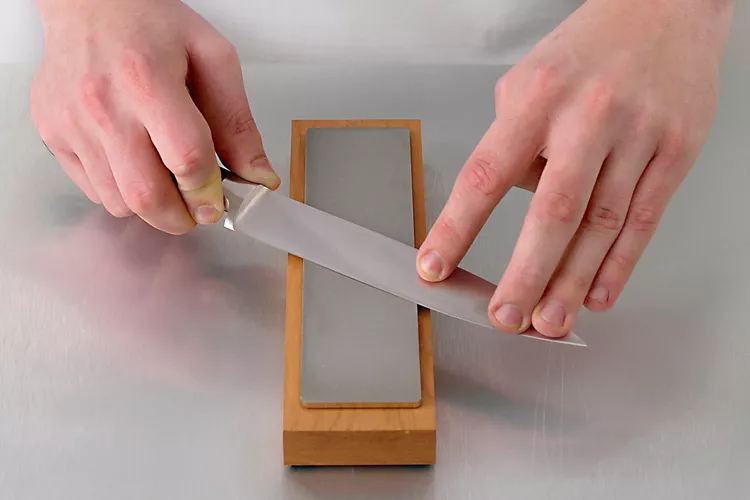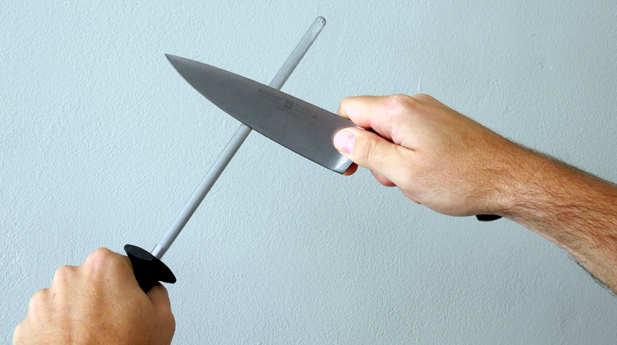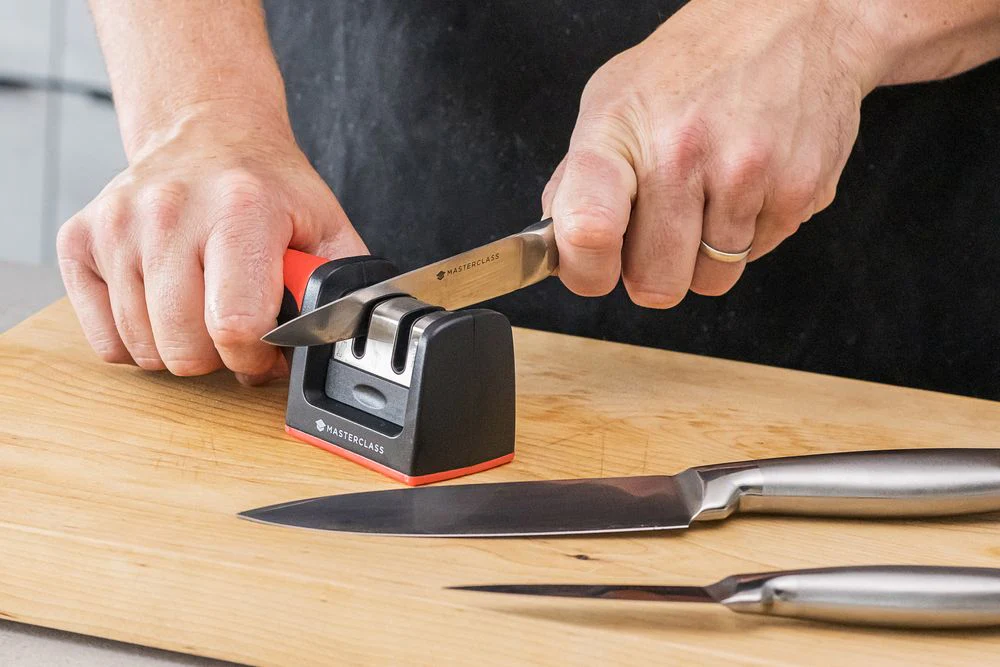Chefs and cooking enthusiasts know the value of a sharp knife. Cooking with a dull knife might be deadly. Knowing how to sharpen a knife is crucial. This detailed article will cover knife sharpening procedures and tools. Let’s start with your favorite chef’s knife!
Why Sharpening Your Knife Matters
Food safety requires a sharp knife. Sharp knives cut ingredients easily and accurately. Blunt knives slip and cause mishaps, extending and worsening cutting.
Dull knives require more effort, which might damage food. Sharpening your knife ensures optimal functionality and preserves a useful cooking tool.
What to Use to Sharpen a Knife: Essential Tools

Few equipment are needed to sharpen a knife. Examine each:
Whetstone
A whetstone, or sharpening stone, is a trusted knife sharpener. Flat, multi-grit stone. The rougher side sharpens, while the finer side polishes. Whetstones come in water, oil, and diamond varieties. They allow accurate knife edge angle control and sharpening.
Honing Rod
A long, cylindrical steel or ceramic instrument called an honing rod sharpens. It keeps the knife sharp between sharpenings. A honing rod straightens and sharpens the knife’s minuscule teeth. This tool is great for quick touch-ups and can substantially prolong sharpenings.
Knife Sharpener
Knife sharpening systems are useful for guided sharpening. The base has angle guides and sharpening stones or rods. For beginners or those who seek a simple sharpening process, they deliver consistent and accurate results. Some systems offer customizable angles and abrasive grits.
Electric knivesharpeners
Electric knife sharpeners are simple and fast. These tools sharpen knives with rotating abrasive wheels or belts. Due of their speed and simplicity, home cooks and chefs love them. To avoid over-sharpening, choose a good electric sharpener.
Sharpening Stone
Sharpening stones can sharpen knives and other cutting tools. A rectangular abrasive block is usual. Sharpening stones have coarse to fine grits. The right grit can sharpen your knife. They generate great effects but take practice and skill.
Methods for Sharpening a Knife

Knife sharpening has many approaches. Common methods include:
Whetstone: Whetstones are used to sharpen knives. It has coarse and fine-grained sides. Wet the stone and set it down.
Holding the knife at a 20-degree angle, brush the blade across the stone with constant pressure. Alternate between the coarse and fine sides of the stone to sharpen the blade on both sides.
Honing Rod: A honing rod, often called a sharpening steel, realigns the knife’s edge without removing metal. Hold the honing rod upright and slightly angled.
Hold the knife handle firmly and place the rod base on a secure surface. Slide the knife down from the rod base with little pressure and a steady angle. Repeat on both blade sides numerous times.
Electric knife sharpeners sharpen blades with revolving abrasive wheels. Place the knife in the slot and follow the sharpener’s instructions. Read the instructions to use safely and effectively.
Electric Knife Sharpener: Guided Sharpening System: Sharpening jigs or angle guides help maintain control and a uniform angle. These techniques use sharpening stones and other abrasives. To sharpen, follow the guided sharpening system instructions.
Professional Sharpening Services: If you’re not comfortable sharpening your knives or they need extensive repair, try professional sharpening services. Kitchen supplies, cutlery, and mail-in services offer these services. Professionals sharpen knives well.
How to Maintain a Sharp Knife

Frozen food and bones might ruin your knife.
To avoid corrosion and rust, wash and dry your knife after use.
Knife blocks, sheaths, and magnetic strips protect blades from dulling and damage.
Hone your knife using a rod to sharpen and realign it.
Sharpen your knife using a stone or system as needed.
To avoid nicks or dulling, store or transport your knife with a knife guard or blade cover.
Avoid abrasive or metal implements on cutting surfaces to avoid blade wear.
If you’re unclear how to sharpen your knife or it needs extensive restoration, have it professionally sharpened.
Common Knife Sharpening Mistakes to Avoid

Avoid frequent blunders when sharpening your knife. Avoid these errors:
Incorrect angle: Sharpening at the wrong angle might produce an ineffective or uneven edge. Always follow the manufacturer’s instructions or aim for 15-20 degrees.
Inconsistent pressure: Inconsistent pressure while sharpening might cause an uneven edge. Maintain gentle pressure throughout sharpening.
Overusing the coarse grit: Avoid overusing the coarse grit on a sharpening stone with multiple grits. It’s necessary for initial sharpening, but too much use might wear down the knife.
Neglecting the finer grit: After using the coarse grit, spend time on the finer side of the stone. This is essential for sharpening the edge.
Not cleaning the knife: Metal particles or debris left behind after sharpening might damage cutting ability and cause contamination.
Rushing: Knife sharpening requires patience and precision. Rushing can compromise quality. Keep your technique steady and slow.
Common Questions
Electric knife sharpeners for all knives?
Most knives—kitchen, hunting, and pocket—can be sharpened with an electric knife sharpener. However, be sure your knife’s electric sharpener matches the manufacturer’s specifications.
Choose an electric sharpener that fits your knife’s blade length and thickness.
Ceramic knives: sharpenable?
Ceramic knives need particular sharpening due to their substance. Use ceramic knife-specific diamond sharpening stones. Whetstones and honing rods can ruin ceramic blades. If you’re unsure about sharpening ceramic knives, consult a professional ceramic blade sharpener.
Is my knife sharp enough?
A sharp knife should easily cut paper, cardboard, and ripe fruits and vegetables. A dull knife pulls, tears, or requires extra force to cut. You can test your knife’s sharpness by lightly slicing a piece of paper or cutting it.
Honing vs. sharpening?
Honing and sharpening are interchangeable but separate techniques. Honing aligns the blade’s edge between sharpenings. Honing rods or sharpening steels straighten the minuscule teeth along the edge.
To sharpen the blade, a small quantity of material is removed. Sharpening stones, systems, or electric sharpeners are used.
Do leather strops sharpen knives?
Leather strops polish and refine knife edges, not sharpen them. After sharpening, it removes burrs and flaws for a razor-sharp finish. Stropping the knife’s edge against leather improves cutting and polishes it. A leather strop may not be enough to sharpen a dull knife.
Conclusion
Cooking safely and efficiently requires a sharp knife. You can keep your knives sharp by using the right tools and methods. Follow proper practices and care for your knives whether you use a whetstone, guided sharpening system, or electric sharpener.
When choosing a sharpening procedure, consider the knife type, frequency of usage, and your skill. Honing and cleaning can keep your knife sharp between sharpenings.
If your knife becomes dull, you’ll know how to sharpen it and bring precision back to your cooking.
